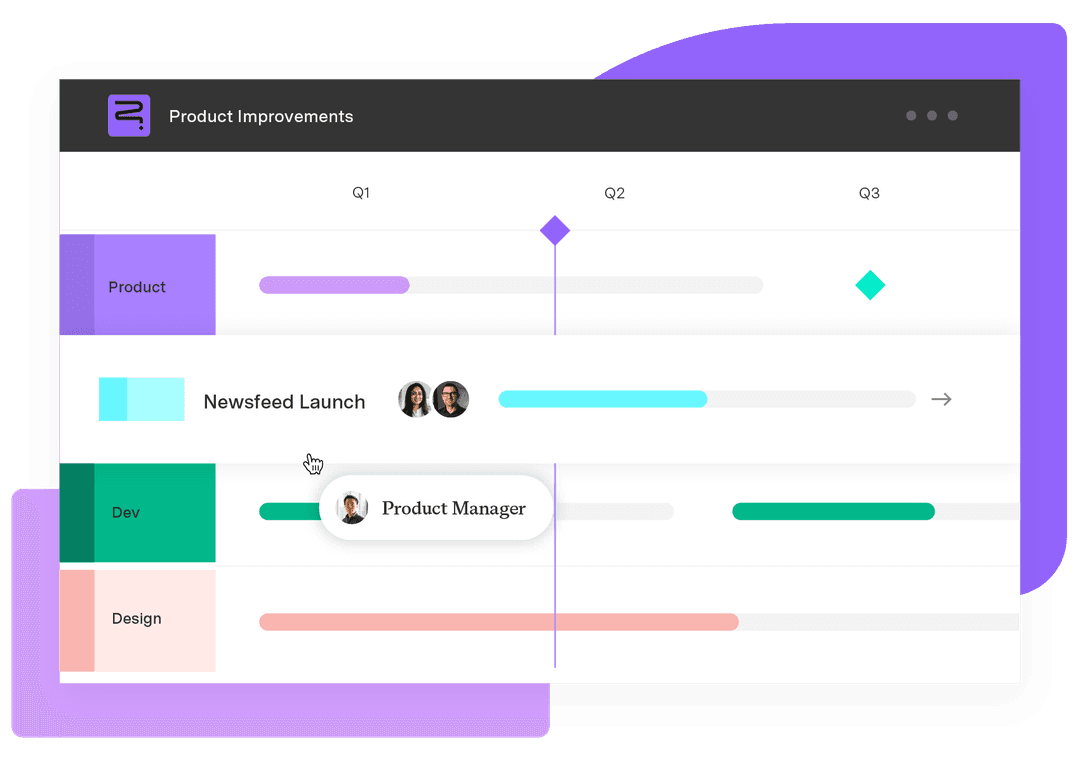Goal-setting software: Connect high-level objectives to everyday work
Tempo Team
A project manager is responsible for setting precise and measurable goals that help their team visualize each initiative’s finish line. However, they need more than just a clear view of the destination to keep the journey on track.
Even the most well-defined goals require careful tracking and execution. Spreadsheets alone can’t handle complex objectives, and they quickly buckle under the weight of large-scale projects.
Fortunately, goal-setting software offers a more nimble solution. Comprehensive tracking tools help leaders maintain alignment and accountability on big-picture strategy and daily execution. In this guide, we’ll explore how goal-setting applications work, explain their benefits, and identify advanced platforms that give teams more than a simple to-do list.
What is goal-setting software?
Goal-setting software is a digital tool that helps users track and achieve their objectives. Unlike static documents or spreadsheets, these platforms provide dynamic frameworks that improve alignment and follow-through.
Goal-setting software offers a centralized space to create and organize goals, measure progress, and break larger objectives into key results. These tools align everyday work with overarching strategies by connecting goals to real-time data and day-to-day tasks.
Manual tracking methods have pitfalls like unclear ownership and poor visibility. Goal-setting software solves this by providing live dashboards that everyone can access. It brings consistency to goal tracking, helping teams collaborate across an organization.
Goal-setting and goal-tracking software provide the following productivity-boosting features:
Automated updates: Spreadsheets require manual input, but goal-setting tools link to work systems (like Jira or product management tools) to automatically update progress.
Real-time visibility: With purpose-built software, team members and leaders can see progress live and watch analytics update in real time.
Built-in accountability: Most goal-setting platforms let users assign task ownership, set deadlines, send reminders, and track progress. Spreadsheets require extensive customization to perform these tasks – if they’re possible at all.
Structured goal methodologies: Tools often include frameworks to track objectives and key results (OKRs) and implement SMART goals (specific, measurable, achievable, relevant, and time-bound).
Integration with workflow tools: Many platforms connect with task management tools (e.g., Jira), messaging apps (e.g., Slack), resource management tools (e.g., Capacity Planner), and more, enhancing a team’s existing tech stack.
The importance of goal-setting software
Teams struggle to maintain alignment when updates are scattered across spreadsheets and informal check-ins. Goal-setting apps help track progress and connect teams to broader business outcomes. They create a shared source of truth for goal management. Rather than juggling documents or trying to remember who owns what, teams can work from a shared platform where every objective is visible and measurable.
Visibility matters even more in dynamic, high-growth, or remote work environments. As complexity increases, so does the risk of misalignment. Goal setting and tracking give teams the structure and agility to stay coordinated without micromanagement.
Best of all, goal-planning software doesn’t just support individual initiatives; it enables improvements and insights to carry over, yielding long-term benefits. Built-in analytics tools uncover patterns that inform the planning process for future projects. Leaders can see where workflows tend to stall, which teams consistently deliver, and what objectives drive the most value. Spreadsheets can’t offer that level of insight without manual analysis.
Best goal-setting software tools
A goal-setting platform should help teams track progress at scale and connect everyday work to strategy. Here are some of the best tools to streamline goal planning and implementation:
1. Tempo
Tempo is built to help Jira teams align strategy with execution. Tools like Strategic Roadmaps and Timesheets allow teams to track progress, budgets, and time spent from a central hub, closing the gap between planning and delivery.
By embedding capacity planning, predictive scheduling, and portfolio-level roadmapping directly into Jira, Tempo helps agile teams coordinate sprint delivery without leaving their primary workflow. Jira integration highlights resourcing issues early and simplifies timeline adjustment, so goals remain achievable as work evolves.
2. Lattice
Lattice is a people management platform with built-in OKR tracking. It helps HR and leadership teams align employee performance with business goals – ideal for organizations that want to foster a culture of accountability and improvement.
3. Asana
Asana combines task management with executive-level goal tracking. Teams can break strategic objectives into actionable projects and monitor progress visually. It integrates with various tools and is well-suited for cross-functional collaboration.
4. Notion
Notion is a flexible workspace that can be customized for goal setting, project planning, and documentation. Teams can use templates or build custom goal tracker dashboards and progress bars that match their workflow. Although it’s less structured than purpose-built OKR tools, its flexibility is a plus for creative teams.
5. ClickUp
ClickUp’s feature-rich platform supports task management and time tracking in one place for streamlined operations. Its Goals feature lets teams create measurable targets, set deadlines, and link them to specific tasks. ClickUp also includes a customizable goal tracker dashboard so teams can visualize progress across objectives.
6. Weekdone
Weekdone is designed around the OKR framework and geared toward helping teams stay aligned on a weekly basis. Its simple visual goal tracking and status reports make it ideal for smaller teams or companies that are new to structured goal-setting practices.
7. 15Five
15Five combines goal tracking with performance management and employee engagement tools. It supports OKRs, weekly check-ins, and feedback delivery. It’s well-suited for HR teams and aligns people development with organizational goals.
Align goal-setting, planning, and execution with Tempo
If managers make plans in one system and execute them in another, they risk misalignment and missed targets. Tempo’s tools close that gap by embedding strategic goal tracking directly into Jira, where teams already plan and manage their work.
With Strategic Roadmaps, teams can define SMART goals and map them to Jira epics. This creates a visual connection between objectives and their required tasks. Custom roadmaps allow teams to plan across multiple time horizons and adjust course as priorities shift.
Tempo’s Timesheets adds another layer of productivity insight by capturing time spent. Leaders gain better visibility into resource allocation and a clearer understanding of the effort behind key initiatives. By linking time tracking to goals, teams can better assess progress and recalibrate goals based on constraints.
Tempo’s tools work best in an integrated ecosystem. A product team at a SaaS company might use Strategic Roadmaps to map quarterly OKRs to Jira epics, with each initiative tied to a business outcome. Meanwhile, engineering hours are tracked in Tempo Timesheets to stay within sprint capacity and meet delivery deadlines.
Try Tempo today and see how Strategic Roadmaps and Timesheets can incorporate strategic planning into your team’s daily work.












































